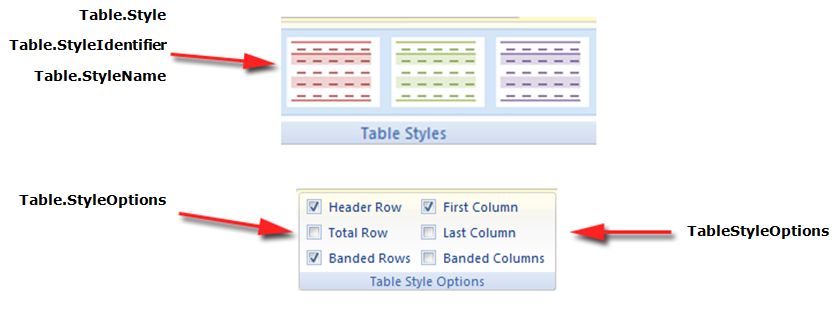Analyzing your prompt, please hold on...
An error occurred while retrieving the results. Please refresh the page and try again.
表格样式定义了一组可以轻松应用于表格的格式设置。可以在表格样式中设置边框、底纹、对齐方式和字体等格式,并将其应用于多个表格以获得一致的外观。
Aspose.Words 支持将表格样式应用于表格,还支持读取任何表格样式的属性。在加载和保存期间通过以下方式保留表格样式:
用户可以创建新样式并将其添加到样式集合中。 Add方法用于创建新的表格样式。
以下代码示例显示如何创建新的用户定义的表格样式:
如果需要,您可以使用 AddCopy 方法将某个文档中已存在的表格样式复制到样式集合中。
重要的是要知道,通过这种复制,链接的样式也会被复制。
以下代码示例演示如何将样式从一个文档导入到另一个文档:
Aspose.Words提供了一个继承自Style的TableStyle类。 TableStyle 方便用户应用不同的样式选项,如阴影、填充、缩进、CellSpacing 和 Font 等。
此外,Aspose.Words 提供了 StyleCollection 类和 Table 类的一些属性来指定我们将使用哪种表格样式:Style、StyleIdentifier、StyleName 和 StyleOptions。
Aspose.Words 还提供 ConditionalStyle 类(表示应用于具有指定表格样式的表格某些区域的特殊格式)以及表示 ConditionalStyle 对象集合的 ConditionalStyleCollection。该集合包含一组永久项目,代表 ConditionalStyleType 枚举类型的每个值的一个项目。 ConditionalStyleType 枚举定义了可以在表格样式中定义条件格式的所有可能的表格区域。
在这种情况下,可以为 ConditionalStyleType 枚举类型下定义的所有可能的表格区域定义条件格式。
以下代码示例显示如何定义表标题行的条件格式:
您还可以选择要应用样式的表格部分,例如第一列、最后一列、带状行。它们列在 TableStyleOptions 枚举中并通过 StyleOptions 属性应用。 TableStyleOptions 枚举允许按位组合这些功能。
以下代码示例演示如何创建应用了表格样式的新表:
下图显示了 Table Styles 在 Microsoft Word 中的表示及其在 Aspose.Words 中的相应属性。

表格样式定义了一组可以轻松应用于表格的格式设置。边框、底纹、对齐方式和字体等格式可以在表格样式中设置,并应用于多个表格以获得一致的外观。
Aspose.Words 支持将表格样式应用于表格,还支持读取任何表格样式的属性。在加载和保存期间通过以下方式保留表格样式:
目前,您无法创建新的表格样式。您只能将文档中已存在的内置表格样式或自定义表格样式应用到表格。
Aspose.Words 还提供 ExpandTableStylesToDirectFormatting 方法来获取表格样式上的格式并将其扩展为表格的行和单元格作为直接格式。尝试将格式与表格样式和单元格样式结合起来。
以下代码示例演示如何将格式从样式扩展到表行和单元格作为直接格式:
Analyzing your prompt, please hold on...
An error occurred while retrieving the results. Please refresh the page and try again.